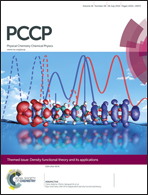Information and complexity measures in molecular reactivity studies†
Abstract
The analysis of the information and complexity measures as tools for the investigation of the chemical reactivity has been done in the spin-position and the position spaces, for the density and shape representations. The concept of the transferability and additivity of atoms or functional groups were used as “checkpoints” in the analysis of obtained results. The shape function as an argument of various measures reveals less information than the spinor density. Use of the shape function can yield wrong conclusions when the information measures such as the Shannon entropy (SE, S), the Fisher information (FI, I), the Onicescu information (OI, D), and complexities based on them are used for the systems with different electron numbers. Results obtained in the spinor-density representation show the transferability and additivity (while lacking in the case of the shape representation). The group transferability is well illustrated in the example of the X–Y molecules and their benzene derivatives. Another example is the methyl group transferability presented on the alkane–alkene–alkyne set. Analysis of the results displayed on planes between the three information-theoretical (IT) based measures has shown that the S–I plane provides “richer” information about the pattern, organization, similarity of used molecules than the I–D and D–S planes. The linear relation of high accuracy is noted between the kinetic energy and the FI and the OI measures. Another interesting regression was found between the atomization total energy and the atomization entropy. Unfortunately, the lack of the group electronic energy transferability indicates that no general relations between the IT measures and the chemical reactivity indices are observed. The molecular set chosen for the study includes different types of molecules with various functional groups (19 groups). The used set is large enough (more than 700 molecules) and diverse to improve the previous understating of molecular complexities and to generalize obtained conclusions.


 Please wait while we load your content...
Please wait while we load your content...